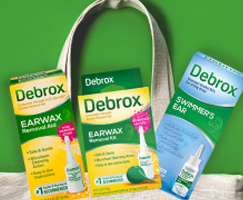Ear Care Education
What Makes Earwax Build Up?

At one point or another in life, everyone experiences earwax buildup. What makes earwax build up? Why does it happen in some people more than others?
Find out why earwax builds up, why some people have more earwax buildup than others, and how to remove earwax buildup safely.
What is earwax?
Earwax is really a liquid called cerumen that is produced by glands in the skin of the ear canal. This sticky liquid helps protect the inner ear from bacteria, bugs, dirt and dust particles. Part of the magic of the ear is that it’s self-cleaning—as you chew or talk, the earwax moves from the ear canal to the ear opening. Then it usually dries into flakes and falls out.
Why does earwax build up?
Sometimes the natural cleaning process can be affected by things that we do. And some people are just more prone to earwax buildup and blockage. For example:
- If a person has a narrow or oddly shaped ear canal, earwax may not move as easily through the canal and out of the ear, and cause a blockage.
- If you use a cotton swab to clean your ears, you may be pushing wax further into the canal without realizing it.
- If you use in-ear headphones frequently, this could be causing earwax to be pushed back and build up.
- Certain health conditions, such as eczema, can also cause wax to build up.
Hearing aid users and elderly adults may be more at risk of earwax buildup and blockage. Hearing aids present a double whammy—they can block the earwax from drying and flaking off and, because they are in the ear for a prolonged time, they can trigger the cerumen glands to produce more wax. Elderly adults can be at risk simply because of biology—earwax becomes harder and less mobile as we age.
What you can do to prevent or treat earwax buildup
Removing earwax buildup is important to avoid impaction (blockage). Impacted earwax can cause hearing loss, dizziness, ringing in the ears, itchy ears and even infection. It can be especially disorienting for people with dementia or other health conditions that affect the senses or mobility. If earwax is blocking your ears and causing these symptoms, you may need to go to your doctor to get your ears examined and resolve the blockage safely.
If you have excessive earwax that has built up but is not fully impacted, you can use doctor-recommended Debrox earwax removal drops to help soften and loosen the earwax so it can drain out of the ear canal.
Prevention is your best bet to save time and protect your ear and hearing health. Follow the tips that apply to you:
- Never stick a swab close to or into your ear canal.
- Gently wipe your ears with a damp cloth when needed. Do not over-clean.
- Take frequent and long breaks from using in-ear headphones; clean the headphones and wipe your ears after each use.
- Use over-ear headphones (or no headphones) instead of in-ear headphones.
- Clean and use your hearing aid as directed to help prevent earwax from building up and to keep earwax from damaging your device.
Anytime you have ear pain or loss of hearing, call your doctor for advice. For normal earwax buildup, keep at least one Debrox® Earwax Removal Kit along with your self-care supplies. Be sure to check for a coupon on our site before you buy.

